How to fight a casino in Coney Island
The fight against a massive casino in Coney Island starts this week
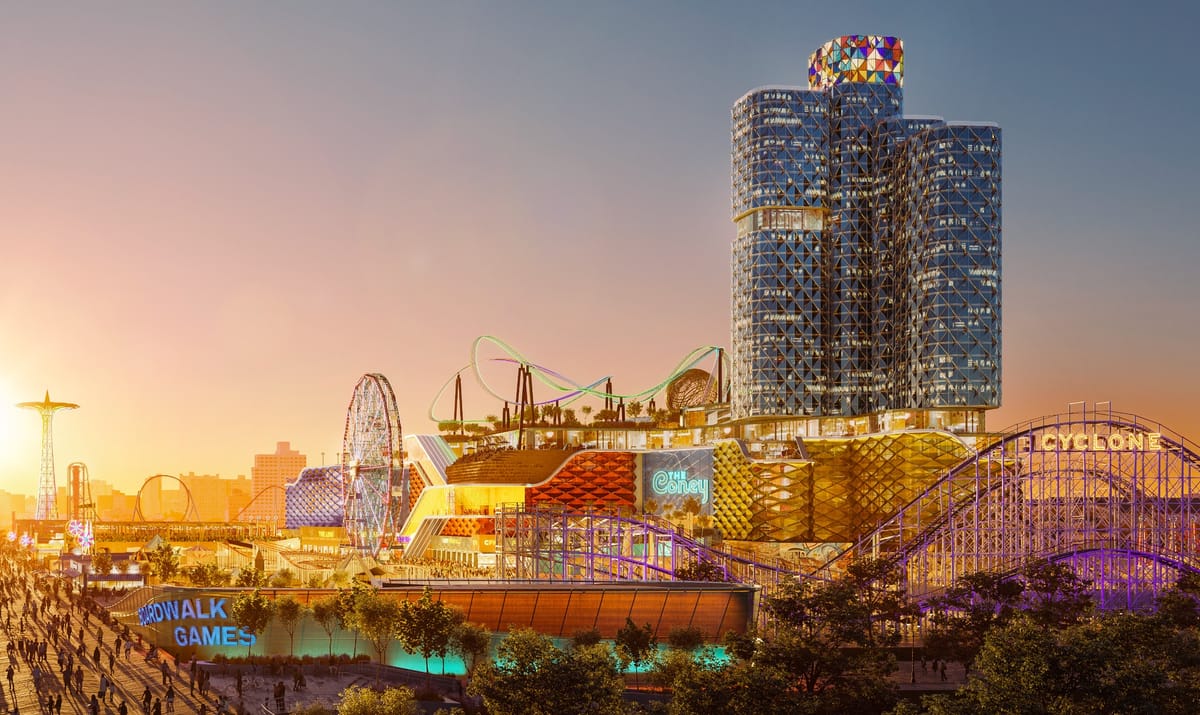
A company that owns several large pieces of prime real estate in Coney Island has been promising to “revitalize” the People’s Playground since the second Bloomberg administration, but its biggest swing in years was a crab restaurant opening in one of its buildings on Stillwell Avenue. Now, it says it has a new answer: a casino that would dominate the skyline and remake the DNA of the destination. Coney Island residents and visitors disagree; they’re starting to fight back this week, and are asking for help.
Thor Equities, the developer, and its grand real estate plans have been looming over Coney Island since before Luna Park opened in 2010. A 2011 NY1 video talks of plans to replace Coney’s old buildings (“horrible rundown relics with nothing exciting about them,” according to Thor’s chairman Joe Sitt in the video) with hotels and a waterpark, neither of which materialized. Its only major announcements in recent years came in a 2021 release bragging about adding a Crab Du Jour to its properties, right before the crab bubble burst. The restaurant closed shortly after. Mostly, its properties are known locally for looking like any other abandoned lot in the city, full of rusty fencing, cracked asphalt and rat nests, until the summer, when a few shipping containers host pop-up food vendors selling novelty sized frozen drinks.
Now, the same developer is asking for permission to turn Coney Island from a gritty boardwalk town into a glitzy casino center.
“There's only one Coney Island. It's such a singular thing,” Coney resident Marissa Solomon told The Groove. “There's a million other nondescript casino developments in a million other places. And you're going to replace this singular thing with something that's so common?”
Opponents of the proposal are pushing back, and plan to pack a Brooklyn community board 13 meeting tonight (Jan. 9) to express their opposition to the casino, archly called The Coney. The plan is still in its very early stages, but renderings released in the spring have sent the Coney Island faithful into panic mode.
Here's how casino opponents say you can help:
• Attend the Community Board meeting tonight (Jan. 9) in person or by Zoom: 7pm, Coney Island YMCA, 2980 W.29th St., second floor.
• Follow the NoConeyCasino Instagram account to stay updated.
• Contact elected officials to speak out about it: find details and a prompt here.
• Support Coney year-round: the Freak Bar and Coney Island Museum are open all winter long on weekends, with shows in the theater throughout the season.
The community board meeting this week will go over an application to “demap” the streets from West 12th to West 15 under the proposed casino — a process of taking public throughways off the street grid and turning them over to private hands. Nathan’s and the Coney Island USA building would be islands of old among a shining sea of new construction. The casino complex would eventually require removing some rides and attractions. For the casino, Thor is partnering with Chickasaw Nation, which owns a string of casinos in Oklahoma, many of which have an address situated on a highway.
“If you're in Coney Island, you're at the beach, you're supposed to be outside in the sunshine on the ride, in the water,” said Solomon, whose connection to the amusements goes back to her great grandparents, who used to sell candy apples on the boardwalk and give change at an arcade under the old Thunderbolt, “not inside some dark casino building gambling your money away, where you can do that a million other places.”
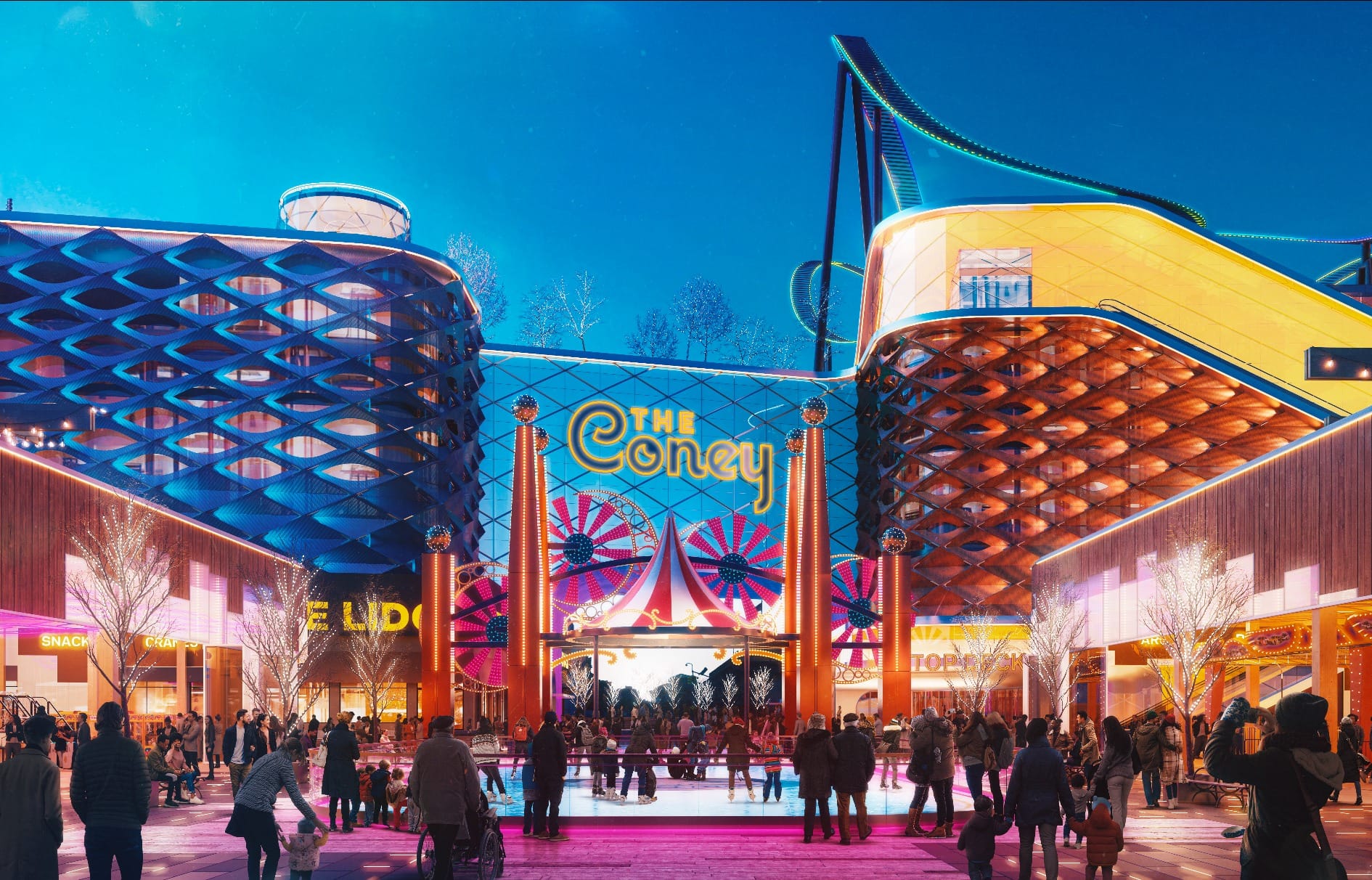
The casino plan is far from a sure thing. The crux of it is whether Thor could obtain one of the state’s three licenses that will be available to open a casino downstate. That already puts them in a scrum with Mets owner Steve Cohen and several other deep-pocketed developers fighting for the licenses. A Manhattan community board this week rejected a proposal from a different developer for a casino in Hudson Yards; community board 11 in Bensonhurst, however, unanimously backed the Coney casino plan last year. The community board meeting is just the start of the process; it will still need to climb a tall ladder of approvals, including an environmental impact statement, borough president review and City Council review.
But The Coney plan aims to eat up a large chunk of the amusement district— from the roads to the sky — with new towers and skyways dwarfing boardwalk iconography like the Parachute Jump and the Wonder Wheel. The $3 billion plan calls for a single casino complex that would span the three blocks along Surf Avenue to make room for a 500-room hotel, convention center, retail and concert venue, and, of course, tons of space for gambling.
The 1.3 million square feet of the casino would be the first thing you’d see when getting off the train, its lights would glare over the boardwalk and the iconic views from the top of the Cyclone would be half guzzled by hotel towers.
“It’s just frustrating, to have to wake up to this,” said Adam Rinn, the artistic director of Coney Island USA, the nonprofit that runs the Circus Sideshow, Mermaid Parade, Freak Bar and the Coney Island Museum. “End this, nobody wants this casino, that’s the bottom line. Put it up in the mountains away from everyone and everything, with a huge parking lot and it doesn’t matter.”
Coney Island has been home to casinos in the past (and still has its share of house-always-wins boardwalk games), but they’re a far cry from the modern pitch. The goal of a casino is to get you to stay inside; not exactly the beer-cheersing people-watching you get from a seat at Ruby’s on the boardwalk. Gambling addiction is as nasty as drug addiction and its hold on America in only growing stronger.
“When you walk around the periphery of these gambling towns, they're sleazy, they’re decrepit,” Rinn said.
On its website, The Coney says it will reach out to local businesses to support and partner with them, but Rinn — whose organization houses and defends the heart of Coney's history — said Thor has never reached out to them.
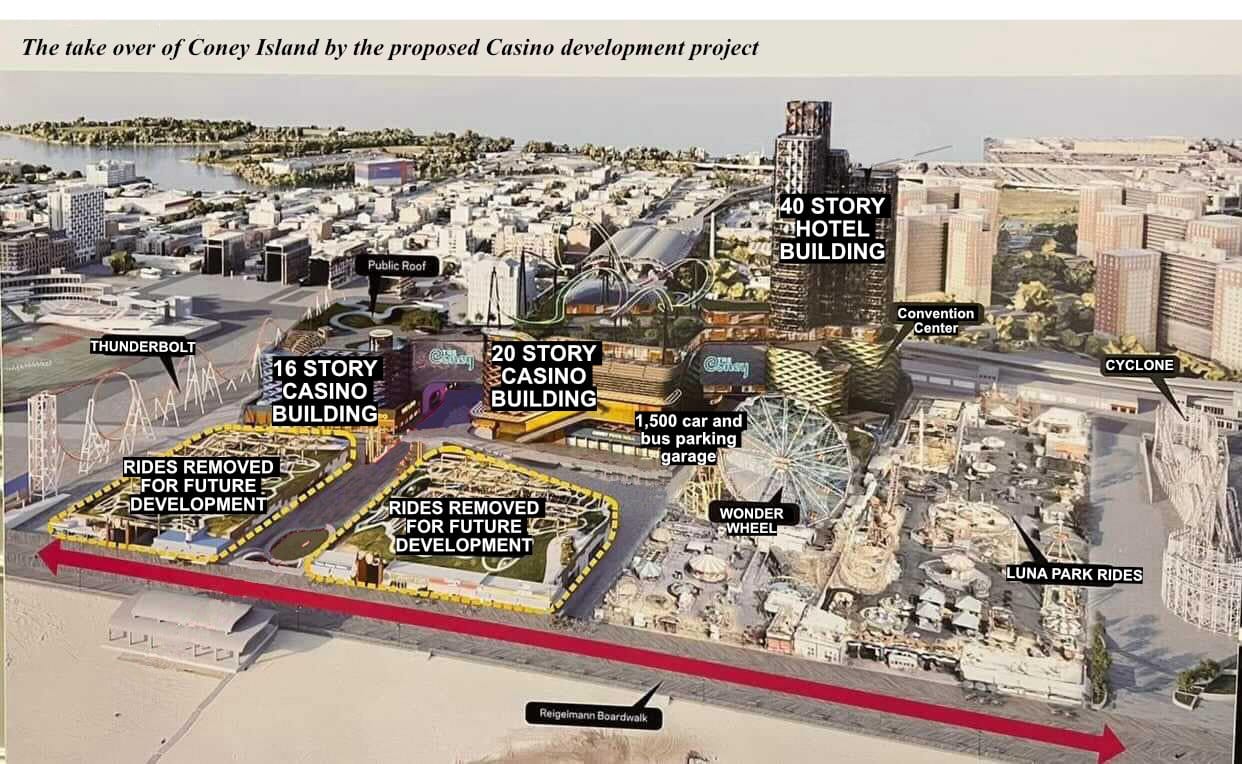
The not-so-mighty Thor?
For its part, Thor pledges the casino will create jobs and bring year-round traffic to the boardwalk, which has struggled for ages to crack the nut (pun intended) of drawing visitors in the colder months.
“The project's revitalizing power will help drive a Coney Island comeback for a community that has lagged behind Brooklyn and the rest of New York City in several areas, including a higher poverty rate, unemployment rate and higher rates of New Yorkers without health insurance,” a spokesman told Gothamist last year (Thor did not respond to a request for comment, nor did City Councilman Justin Brannan, who represents the area).
But Thor has been banging on about Coney Island’s “comeback” for so long now it’s hard to keep track of what Coney is “coming back” from any more: COVID? Sandy? The closure of Astroland in 2008? The time an entire screening of The Warriors got ratfucked?
Thor’s $1.5 billion plan for “Vegas-style” hotels and condos in 2007 went nowhere. A high-ranking city official told The Daily News at the time: "The company has a history of promising grand development projects that will create jobs, getting a zoning change and then flipping the property."
After a big fight to rezone Coney Island’s amusement district in 2009, the company’s first big move finally came in 2011: opening an It’Sugar chain candy store across from the train station. In 2015, the company filled another retail space with a Wahlburgers, the chain owned by the famously-from-Boston Wahlberg family. That closed after a tumultuous two years, despite the fact that it’s not actually that hard to sell hamburgers at a boardwalk.
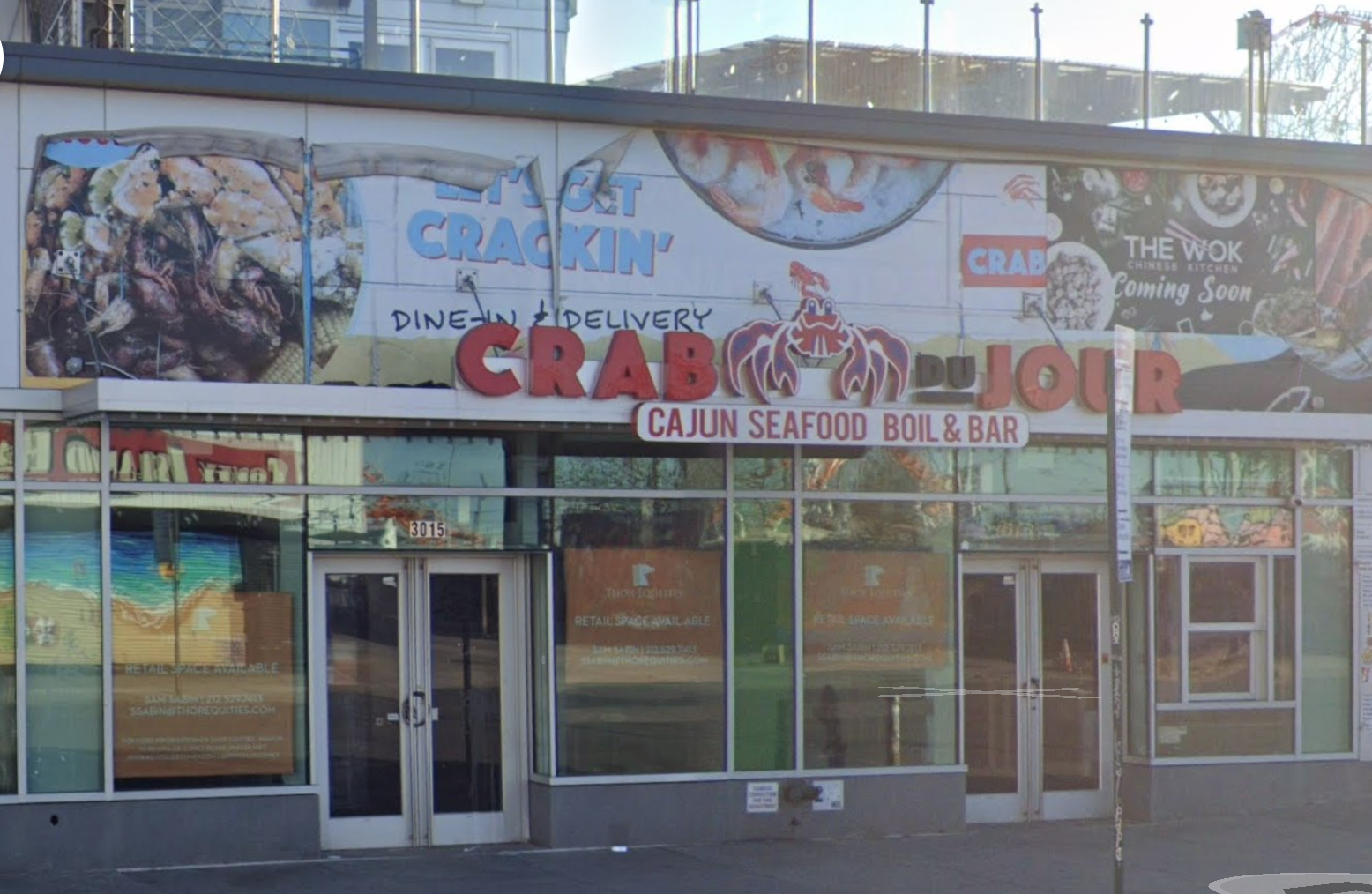
In 2016, Thor was on locals’ good side for a brief period, Rinn said: the company partnered with a local artist to open the Coney Island Art Walls, a showcase for street art and concerts. I saw a very good rock and roll festival called Burger Fest there many years ago (rest in piss to that record label though!). Cardi B played there last summer, but the venue’s website and social media have not been updated since the pandemic. Rinn said the art walls — essentially still just an empty lot — has become more of a nuisance in recent years, as concerts have gotten louder.
“For a hot minute, the art walls were actually kinda cool,” he said. “But otherwise, actually it’s just nothing.”
In 2021, the company demolished Coney’s oldest building, claiming it had fallen into disrepair. In that 2011 video, Sitt showed little regret about demolitions, saying: “the great buildings of Coney Island disappeared 80 years ago.”
The Atlantic City of it all
There are myriad reasons to distrust that Thor and Sitt have the best interests of Coney’s freaky, dirty, bawdy little history at heart. There are just as many reasons to think that a casino is a terrible idea for any neighborhood.
Taking up such a massive chunk of land in one of the most democratically enjoyed places in the city requires the stewardship of a philosopher king, a Willy Wonka mermaid with a billionaire’s pocketbook who can swallow market trends as well as swords and hot dogs. What happens when casinos go out of business because everyone has a mini casino in their pocket at all times now? What will the fate of the complex be when the assets are cut apart and sold to private equity who try to bleed each square inch for maximum profit, creating a half-filled dead mall by the sea?
Brian Rose’s photographs of a post-Trump Atlantic City ghost town are extraordinary https://t.co/3QV1iIoioc pic.twitter.com/UTpzxjTi4K
— Tim Dunn (@MrTimDunn) April 8, 2019
A three hour drive south to Atlantic City provides perfect evidence that the house doesn’t always win. Five major casinos, of varyingly ridiculous architectures, closed in Atlantic City in the 2010s. One of them, bearing the imprimatur of our once-and-future president, was imploded in 2022; city residents gathered to celebrate.
Atlantic City is a place that — and I can say this scientifically, after much research and observation — fucking sucks. There are some edgelords who will tell you Atlantic City has its charms in the breach, aspiring East Coast Hunter S. Thompson types who revel in the grim detritus left in the once-vibrant town, created in large part by our once-and-future president. My dad worked in the Atlantic City casinos for a large part of this life and I grew up tagging along with him on school holidays every now and then, and have seen them from both the gaming room carpet and the back room cafeteria where the employees dine.
The grim dark dungeons are designed to trap you inside, free of any clocks or windows so you can’t see time passing; those insides are full of chain-smoking (yes, still) gray hairs who are shipped in by the busload from North Jersey, cranking away life savings one arm pull at a time. Wander two blocks off the boardwalk and you might as well be in Camden, New Jersey’s other famously economically depressed city. It might be close to the ocean, but Ocean’s 11, it is not.
The opulent wealth hinted at in the casinos (and the proceeds enjoyed, again, by our once-and-future president) has never trickled down to the city at large. Atlantic City frequently is rated among the poorest cities in the state; the median income per person is about $24,000. Last year, city residents bemoaned not having their own supermarket. It is a home to gruesome crime, some of the particularly disturbing variety; a detail in one story has stuck with me for nearly 20 years now: a serial killer targeting sex workers kept arranging their bodies in a drainage ditch outside the city limits, positioning their arms stretched above their heads and turning each of their heads to point east, toward the gleaming lights of Atlantic City.
No need to Showboat
Thinking about the failure of boardwalk casinos reminded me of the Showboat, a New Orleans-themed facility that opened in 1987 and became a case study in Atlantic City’s failures, but its full story was more illuminating than I had thought.
I remembered the news about the casino closing in 2014 and that it was slated to become a campus for Stockton University. But that plan, I learned this week, that never actually happened. Instead, the Showboat had a bit of a comeback: the school sold it to another developer who tried unsuccessfully to reopen the complex as a casino. After failing for years, he pivoted away from gambling and went family friendly, opening the largest arcade in New Jersey followed by the world’s largest beachfront indoor waterpark. By recent accounts, the property is doing well again (though the developer allegedly owes money all over town — again like the once and future president before him).
That’s a long way, and many decades and layoffs, to go just to end up with an arcade and a waterpark by the boardwalk. Should Coney Island skip that whole grubby, income-draining middle part and go directly to the family friendly idea? Year-round ventures have yet to crack the boardwalk’s winter chill, but the recent success of Frost Fest at Luna Park gives some hope.
“We would love Coney Island as an amusement district to have year round entertainment,” Rinn said. “But there are other ways to do this. Stuff that you can a) bring a family to, b) things that are not vices, c) things that will not attract crime and criminals.”
For the opposition, one of the less tangible points is the shadow — both physical and psychic — that a looming casino tower would impose of the island. Coney Island’s amusement area is packed to the nooks with delights, scams and frozen margaritas of unknown strength. It’s also about as sure a place as you can go in the summer to see the chaotic mess of New York City in its full form. You can submerge yourself in the ocean, touch a snake and dance to Boricua music from giant speakers on the boardwalk, be yelled at by hordes of teens and have a nutcracker hand delivered to your beach blanket, and most of that is always free.
“We don’t have a Prospect Park, we don’t have an Owl’s Head Park,” Solomon said. “The boardwalk and amusement area, that’s our open space, that’s our parkland.”
If you enjoyed this story, kick in a few bucks to The Groove's tip jar.



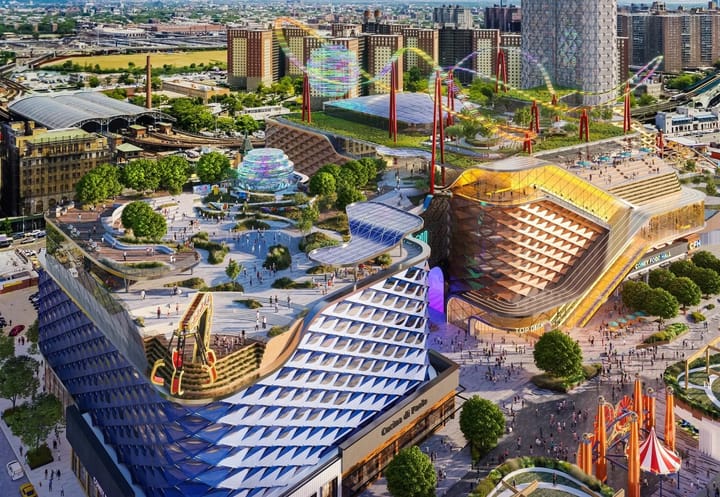
Comments ()